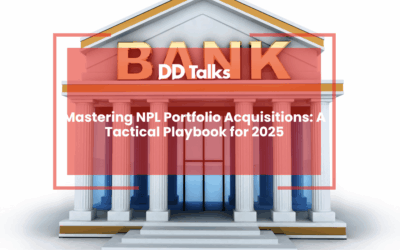Essential Insights for NPL Portfolio Management Success
- The European NPL market holds approximately €300 billion in non-performing exposures, with significant variations in NPL ratios across regions—southern European countries typically maintaining higher levels than northern counterparts.
- Data quality, operational excellence, and local market expertise are the fundamental drivers of successful NPL portfolio management, with timing of market entry significantly impacting potential returns.
- Effective NPL portfolio structuring involves sophisticated segmentation based on collateral type, borrower category, and geographical concentration, with pricing typically ranging from 20-70% of gross book value.
- Technology-enabled precision in distressed debt management—including advanced analytics and machine learning—represents the cutting edge of NPL workout strategies.
- Value creation extends beyond debt collection to strategic asset management, with property enhancement, market cycle timing, and portfolio-level synergies offering significant upside potential.
- Successful investors maintain flexible exit strategies—including individual asset disposals, portfolio sales, and securitization—adapting their approach based on market conditions to optimize returns throughout the investment lifecycle.
Table of Contents
- Understanding the NPL Portfolio Landscape in Europe
- Key Drivers Behind Successful NPL Portfolio Management
- How Are NPL Portfolios Structured and Priced?
- Implementing Effective Distressed Debt Strategies
- Overcoming Common Challenges in NPL Workouts
- Creating Value Through Strategic NPL Asset Resolution
- Exit Strategies for NPL Portfolio Investors
Understanding the NPL Portfolio Landscape in Europe
The European non-performing loan (NPL) market has evolved significantly over the past decade, shaped by the aftermath of the global financial crisis and subsequent regulatory reforms. Currently, NPL ratios vary considerably across European countries, with southern European nations like Greece, Italy, and Portugal historically maintaining higher NPL levels compared to northern counterparts such as Germany and the Netherlands.
The European Banking Authority (EBA) defines NPLs as loans where the borrower is unable to make scheduled payments for 90 days or more. This standardised definition has helped create more transparency in the European NPL market, which currently holds approximately €300 billion in non-performing exposures. Recent regulatory initiatives, including the ECB’s guidance on NPLs and the EU’s Action Plan on NPLs, have accelerated the pace of NPL resolution across European banks.
Market dynamics have shifted dramatically, with specialised investors and servicers now playing crucial roles in the ecosystem. The NPL transaction market has matured, with established platforms in countries like Spain and Italy setting benchmarks for portfolio management practices. Understanding this landscape is essential for investors seeking to navigate the complexities of NPL portfolio management and identify value creation opportunities in this specialised asset class.
Key Drivers Behind Successful NPL Portfolio Management
Successful NPL portfolio management hinges on several critical factors that distinguish top-performing investors from the rest. Data quality stands as perhaps the most fundamental driver, as comprehensive and accurate borrower information enables precise valuation and effective workout strategies. Leading NPL managers invest heavily in data enhancement processes, often deploying advanced analytics to fill information gaps and create more reliable borrower profiles.
Operational excellence represents another crucial element, with efficient servicing platforms capable of handling high volumes of distressed debt while maintaining consistent approaches to borrower engagement. The most successful NPL portfolio managers typically employ specialised teams with deep expertise in local legal frameworks, property markets, and restructuring techniques. This localised knowledge proves invaluable when navigating the complexities of different jurisdictions across Europe.
Timing also plays a pivotal role in NPL portfolio management success. Market entrants who acquired portfolios during periods of banking sector distress have historically achieved superior returns compared to later-stage investors. Additionally, the ability to segment portfolios effectively—identifying which loans warrant restructuring versus liquidation approaches—significantly impacts overall performance. As NPL portfolio ratio analysis demonstrates, the most successful managers achieve optimal outcomes by tailoring their approaches to specific borrower segments rather than applying one-size-fits-all solutions.
How Are NPL Portfolios Structured and Priced?
NPL portfolio structuring and pricing involve sophisticated methodologies that account for numerous variables affecting recovery potential. Portfolios are typically segmented based on several key characteristics: collateral type (residential, commercial, industrial), borrower category (corporate, SME, retail), vintage (age of default), and geographical concentration. This segmentation enables more precise valuation and tailored workout approaches for different loan categories.
Pricing mechanisms rely heavily on discounted cash flow models that project expected recoveries over time. The discount rates applied reflect not only the time value of money but also the risk premium associated with recovery uncertainty. Sophisticated investors employ Monte Carlo simulations and scenario analysis to account for variables like property market fluctuations, legal timeframes, and borrower behaviour patterns. NPL portfolio valuation typically results in significant discounts to gross book value, with pricing ranging from 20% to 70% depending on collateral quality, jurisdiction, and portfolio composition.
Transaction structures have evolved to accommodate different risk appetites and regulatory considerations. Common arrangements include whole loan sales, securitisations with multiple tranches, joint ventures between banks and investors, and servicing-only arrangements where ownership remains with the originating institution. The European NPL market has also seen the emergence of government-backed asset management companies in several countries, creating additional structural options for banks seeking to divest problematic assets while potentially retaining some upside.
Implementing Effective Distressed Debt Strategies
Implementing effective distressed debt strategies requires a multifaceted approach that balances legal enforcement with consensual restructuring options. Successful NPL investors develop clear decision trees for different borrower scenarios, determining when to pursue foreclosure versus when to negotiate payment plans or debt forgiveness. This strategic framework must be supported by robust legal expertise, particularly in jurisdictions with complex foreclosure processes or debtor-friendly legislation.
Portfolio segmentation drives strategy selection, with different approaches applied to various borrower categories. For corporate NPLs, debt-to-equity conversions, operational turnarounds, and business restructuring may create significant value. For retail mortgage portfolios, loan modification programmes that adjust interest rates or extend maturities often prove more effective than foreclosure. The most sophisticated NPL managers maintain flexibility in their approaches, continuously reassessing strategy effectiveness and adapting to changing market conditions.
Technology plays an increasingly important role in distressed debt management, with digital platforms streamlining borrower communication, payment processing, and case management. Advanced analytics help identify which borrowers are most likely to respond to specific intervention strategies, enabling more targeted approaches. Leading NPL servicers are now deploying machine learning algorithms to predict borrower behaviour and optimise workout strategies, significantly improving recovery rates compared to traditional approaches. This technology-enabled precision represents the cutting edge of distressed debt management in Europe’s evolving NPL landscape.
Overcoming Common Challenges in NPL Workouts
NPL workout processes inevitably encounter numerous obstacles that can impede value recovery. Legal system inefficiencies represent one of the most significant challenges, particularly in jurisdictions with overburdened courts and lengthy foreclosure timelines. In countries like Italy and Greece, enforcement proceedings can extend beyond five years, substantially eroding recovery values through time decay and increased holding costs. Successful NPL managers develop specialised expertise in navigating these legal complexities, often establishing relationships with local legal partners who can expedite proceedings.
Information asymmetry presents another formidable challenge, as NPL portfolios frequently come with incomplete or outdated borrower data. This information gap complicates accurate valuation and strategy development. Leading investors address this through comprehensive due diligence processes that include site visits, borrower interviews, and third-party data enrichment. Some have developed proprietary data enhancement methodologies that significantly improve information quality post-acquisition.
Regulatory changes and political interventions can also disrupt NPL workout strategies. Consumer protection measures, foreclosure moratoriums, and banking regulations may shift unexpectedly, altering the viability of planned approaches. Effective NPL portfolio managers maintain regulatory monitoring systems and build flexibility into their workout plans to accommodate potential changes. Additionally, borrower engagement challenges require sophisticated communication strategies that balance firmness with flexibility, particularly in culturally diverse markets across Europe where attitudes toward debt and default vary considerably.
Creating Value Through Strategic NPL Asset Resolution
Value creation in NPL portfolios extends beyond simple debt collection to encompass strategic asset management and optimisation. For real estate-backed NPLs, which constitute the majority of European portfolios, property enhancement represents a significant value lever. Leading investors employ asset management teams that identify opportunities to increase collateral value through renovations, repurposing, or obtaining improved planning permissions before disposal. This approach can transform underperforming assets into attractive investment opportunities, substantially increasing recovery values.
Timing market cycles proves equally important in NPL asset resolution. Sophisticated investors develop holding strategies that align with property market trajectories, sometimes warehousing assets in improving markets rather than accepting immediate liquidation values. This patience can yield substantially higher returns, particularly in recovering markets where property values are appreciating. The most successful NPL managers maintain flexible exit timelines that respond to market conditions rather than rigid disposal schedules.
Portfolio-level synergies offer another avenue for value creation. By aggregating similar assets across multiple NPL portfolios, investors can achieve economies of scale in management costs and potentially command premium pricing for larger, more attractive asset packages. Some investors have successfully created specialised platforms focused on specific asset classes—such as hotel portfolios or logistics properties—extracting additional value through sector expertise and focused management approaches. This strategic clustering of assets represents an advanced value creation technique that distinguishes elite NPL portfolio managers in the European market.
Exit Strategies for NPL Portfolio Investors
Successful NPL portfolio investment ultimately depends on well-planned exit strategies that maximise returns while managing market timing risks. The most common exit approach involves individual asset disposals following workout completion, with properties sold through retail or wholesale channels depending on asset characteristics and market conditions. This granular liquidation strategy typically yields the highest recovery values but requires significant operational resources and extends the investment timeline.
Portfolio sales represent an alternative exit route, particularly for investors seeking faster capital recycling. Secondary market transactions have become increasingly common in mature NPL markets, with specialised investors purchasing partially worked-out portfolios from primary investors. These transactions often occur at reduced discounts compared to original acquisitions, reflecting the risk reduction achieved through initial workout efforts. Some sophisticated investors deliberately structure their NPL acquisition and management approach to facilitate these mid-stream exits.
Securitisation has emerged as another viable exit strategy, particularly for larger portfolios with stabilised cash flows. By packaging performing or re-performing loans into structured securities, investors can access capital markets funding and potentially achieve premium pricing. This approach has gained traction in markets like Ireland and Spain, where regulatory frameworks support securitisation structures. For corporate NPL portfolios, strategic sales to industry buyers sometimes offer premium exits, particularly when operational improvements have enhanced business value. The most successful NPL investors typically maintain multiple exit options, adjusting their approach based on market conditions and portfolio performance to optimise returns throughout the investment lifecycle.
Frequently Asked Questions
What defines a non-performing loan (NPL) in European markets?
According to the European Banking Authority (EBA), a non-performing loan is defined as a loan where the borrower is unable to make scheduled payments for 90 days or more. This standardized definition has created greater transparency across European financial markets, helping investors and regulators assess portfolio quality consistently across different jurisdictions.
Which European countries have the highest NPL ratios?
Southern European nations like Greece, Italy, and Portugal historically maintain higher NPL levels compared to northern European countries such as Germany and the Netherlands. These regional differences reflect varying economic conditions, legal frameworks, and the lingering effects of the global financial crisis that impacted Mediterranean economies more severely.
How are NPL portfolios typically priced in the market?
NPL portfolios are priced using discounted cash flow models that project expected recoveries over time. Pricing typically ranges from 20% to 70% of gross book value, depending on collateral quality, jurisdiction efficiency, and portfolio composition. Sophisticated investors employ Monte Carlo simulations and scenario analysis to account for variables like property market fluctuations and legal timeframes.
What are the main challenges in NPL portfolio management?
The main challenges in NPL management include legal system inefficiencies (particularly in jurisdictions with lengthy foreclosure processes), information asymmetry (incomplete or outdated borrower data), regulatory changes that can disrupt workout strategies, and borrower engagement difficulties. Successful NPL managers develop specialized expertise and flexible approaches to overcome these obstacles.
What technology solutions are improving NPL portfolio management?
Advanced analytics, machine learning algorithms, and digital platforms are transforming NPL management by streamlining borrower communication, optimizing workout strategies, and predicting borrower behavior. These technologies enable more precise portfolio segmentation, targeted intervention approaches, and improved operational efficiency, resulting in higher recovery rates compared to traditional methods.
What exit strategies do NPL investors typically employ?
NPL investors typically use three main exit strategies: individual asset disposals following workout completion (yielding highest recovery values but requiring more time), portfolio sales to secondary market investors (enabling faster capital recycling), and securitization of performing or re-performing loans (accessing capital markets funding). The optimal strategy depends on market conditions, portfolio characteristics, and investor time horizons.
How do successful NPL managers create additional value beyond debt collection?
Value creation in NPL portfolios extends beyond debt collection through strategic asset management, including property enhancement (renovations, repurposing, improved planning permissions), market cycle timing (aligning disposals with property market trajectories), and portfolio-level synergies (aggregating similar assets to achieve economies of scale). These approaches can significantly increase recovery values above baseline projections.




0 Comments